Looking to monetize your photography skills and wondering Where Can I Sell Photos Online? Whether you’re a seasoned professional or just starting to explore the world of stock photography, numerous online platforms can connect you with buyers eager for high-quality visuals. Stock photo websites act as intermediaries, licensing your images to businesses, marketers, and individuals for commercial and creative purposes. In return, you earn a portion of the revenue generated from your work.
This article dives into 15 of the best websites where you can sell photos online, providing a comprehensive guide to help you turn your passion into a profitable venture. We’ll explore each platform’s unique features, commission structures, and target audience, empowering you to make informed decisions and maximize your earning potential in the online photo market.
Best Websites for Selling Photos Online
1. Alamy
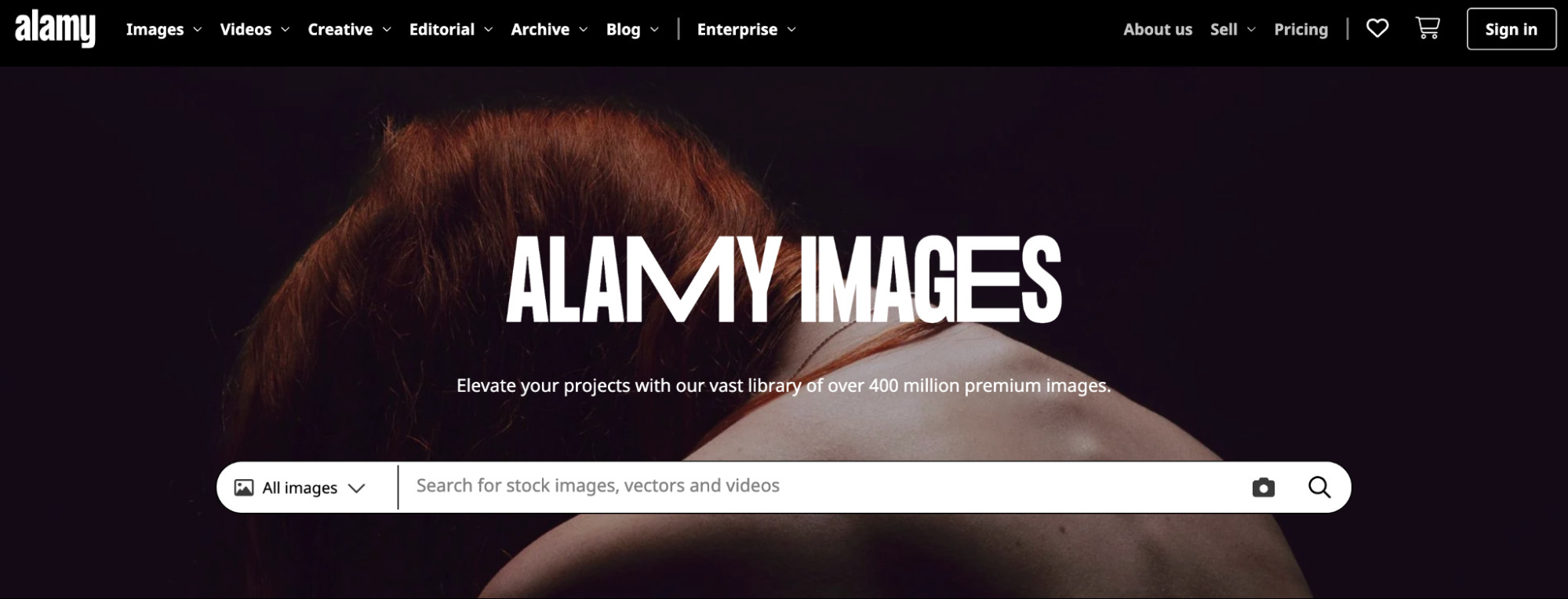 Alamy Images homepage showcasing a search bar for royalty-free image searches.
Alamy Images homepage showcasing a search bar for royalty-free image searches.
Alamy boasts one of the most extensive and diverse stock photo libraries available online. With a vast collection encompassing millions of stock images, vector graphics, videos, and even 360-degree panoramic images, Alamy provides numerous avenues for photographers to contribute and sell their work. They also offer a mobile app, Stockimo, enabling you to directly upload and sell photos taken with your smartphone, broadening accessibility for contributors.
How to get paid
Alamy offers monthly payouts to contributors with various commission structures tailored to image popularity and license types. Photographers can earn between 17% and 50% of each sale. A significant advantage of Alamy is its lack of long-term contracts, providing flexibility for photographers. Payments are processed in multiple currencies, catering to a global contributor base.
2. 500px
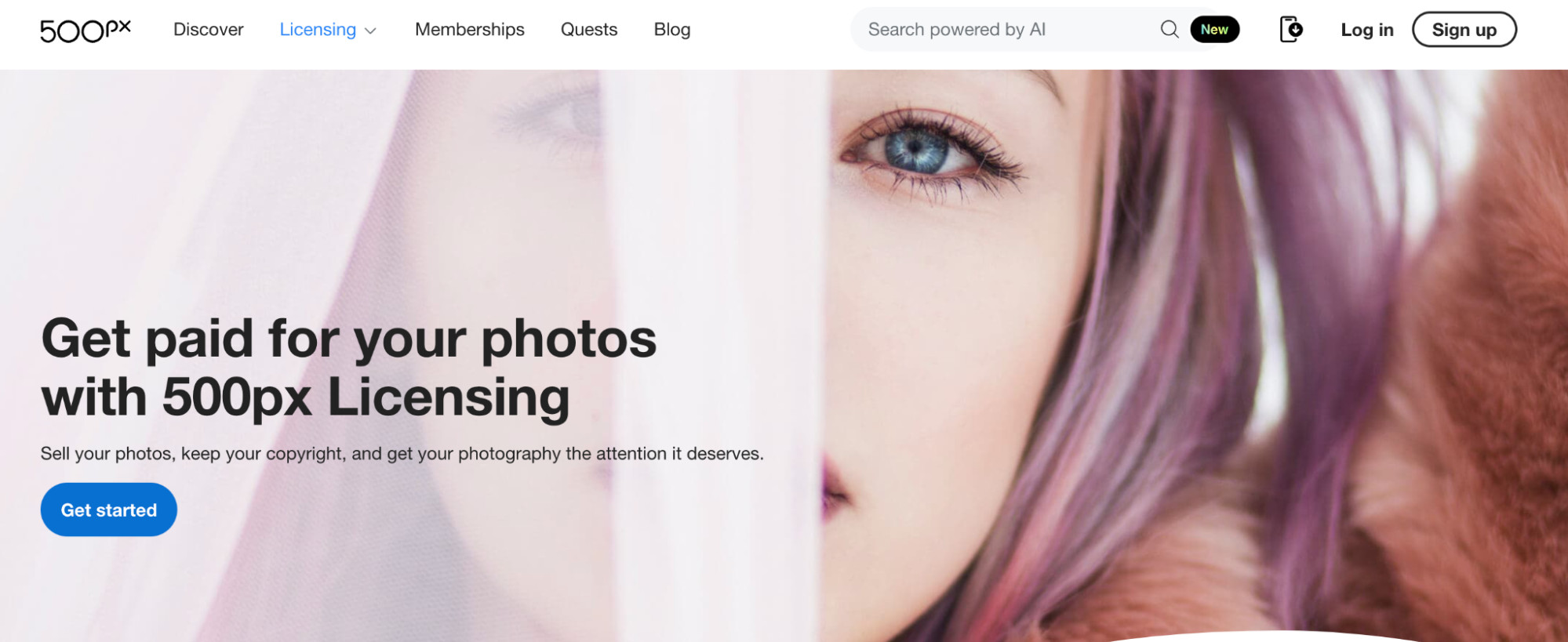 500px homepage highlighting licensing opportunities for photographers to earn money from their photos.
500px homepage highlighting licensing opportunities for photographers to earn money from their photos.
500px stands out by blending stock photo licensing with a vibrant photographer community. This platform hosts a vast network of photographers who actively sell and license their photos online. 500px utilizes its proprietary Pulse algorithm to promote emerging photographers and fresh content to potential clients, offering opportunities for even less experienced photographers to gain visibility, provided their images meet the platform’s quality standards.
Beyond its marketplace functionality, 500px fosters an active online community for both amateur and professional photographers. Users can connect with fellow photographers, receive constructive criticism on their work, participate in online marketplaces, and engage in photography contests with attractive prizes.
How to get paid
Paying members on 500px can earn up to 100% royalties on exclusive photos, making it a potentially lucrative platform for dedicated contributors.
3. Shutterstock
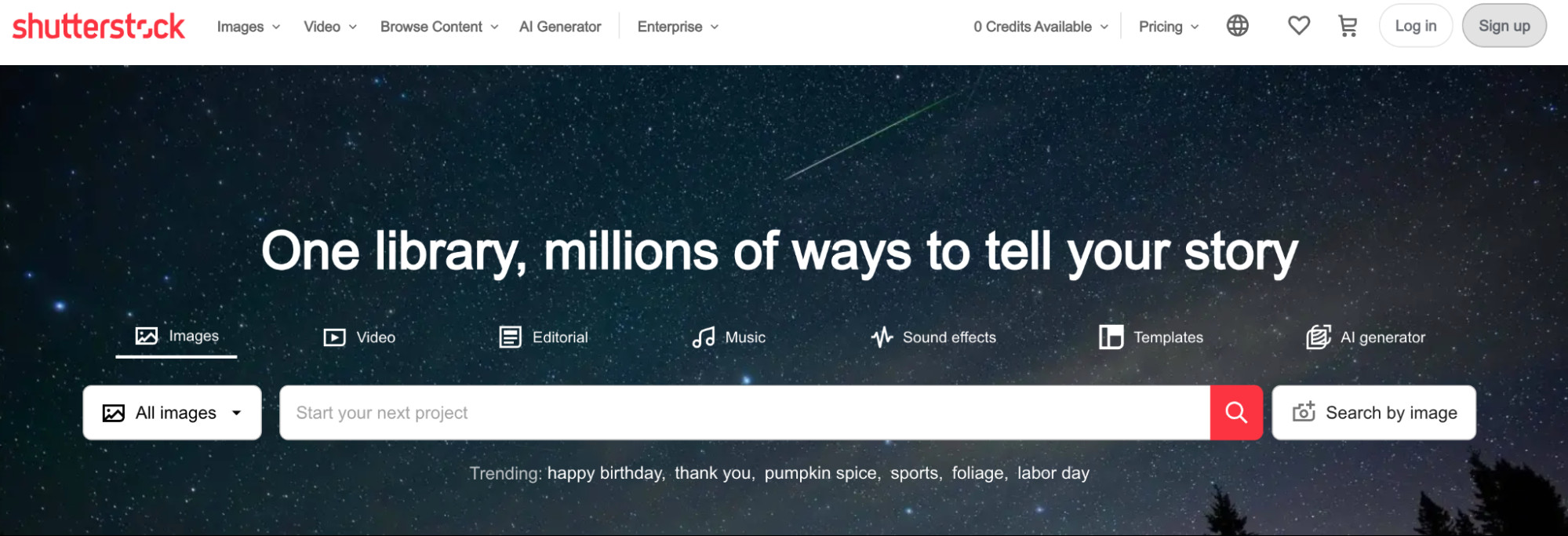 Shutterstock homepage promoting royalty-free images, video, and music for diverse creative needs.
Shutterstock homepage promoting royalty-free images, video, and music for diverse creative needs.
Shutterstock is recognized as one of the most widely used and reputable stock photography websites globally. It’s a well-established platform for selling photos online, having distributed over $1 billion to its contributor community in the past 15 years, highlighting its significant presence in the stock photo industry.
Shutterstock operates as a micro-stock site, characterized by offering photos at more affordable prices and typically on a non-exclusive basis. To maximize earnings on Shutterstock, photographers often focus on contributing a large volume of images. While individual image earnings may be lower compared to some platforms, the high volume potential makes it a valuable starting point for those learning how to navigate the stock photo market.
How to get paid
Payout rates on Shutterstock are progressive, ranging from 15% to 40% based on cumulative earnings over time. Shutterstock also provides an affiliate program allowing contributors to earn additional income by referring new photographers or customers to the platform.
4. Getty Images
 Getty Images homepage featuring a search bar for users to find high-quality stock photos and images.
Getty Images homepage featuring a search bar for users to find high-quality stock photos and images.
Getty Images is synonymous with premium stock photography, attracting high-profile brands and online publishers seeking exclusive, high-quality, or specialized images for licensing. Getty Images, together with its microstock subsidiary iStock, reaches an extensive global customer base of over 1.5 million, demonstrating its significant market reach.
Maintaining its prestigious reputation within the publishing and advertising industries, Getty Images upholds stringent quality standards for photographers looking to sell their work on the platform. The acceptance process is more selective compared to many other stock photo sites, ensuring a consistently high level of image quality.
How to get paid
To become a contributor on Getty Images, photographers need to apply by submitting a portfolio of sample photos for review. Upon acceptance, contributors can earn between 15% and 45% of the image’s license fee. The commission rate varies depending on factors such as image exclusivity and the type of license purchased.
5. iStock
 iStock landing page showcasing a generative AI image creator, highlighting innovation in image creation.
iStock landing page showcasing a generative AI image creator, highlighting innovation in image creation.
iStock operates as the non-exclusive contributor platform affiliated with Getty Images, offering a valuable alternative for photographers. The primary distinction between iStock and Getty Images lies in the exclusivity requirements. Photos on iStock can be offered on a non-exclusive basis, meaning photographers retain the flexibility to sell the same images through other agencies and platforms.
How to get paid
To sell photos through iStock, photographers are required to apply with a selection of sample images for assessment. The commission structure on iStock ranges from 15% to 45%, contingent upon the specific contributor agreement and factors like image type and exclusivity.
6. Stocksy
 Stocksy homepage featuring an artistic graphic of people in a library, representing creative and high-quality stock photos.
Stocksy homepage featuring an artistic graphic of people in a library, representing creative and high-quality stock photos.
Stocksy presents itself as an accessible platform for emerging photographers seeking to sell their photos online, while also offering competitive payouts. Stocksy is known for its attractive royalty rates, offering photographers a 50% royalty on standard licenses and an even higher 75% royalty for extended licenses. However, exclusivity is a requirement; all photos accepted on Stocksy must be exclusive to the platform.
Stocksy operates as an artist-owned cooperative, a unique model where contributors are not just sellers but also part owners of the business. This cooperative structure allows contributors to have a voice in the company’s direction. Furthermore, when Stocksy achieves a surplus, contributors may receive patronage returns, sharing in the financial success of the cooperative.
How to get paid
Stocksy ensures timely payments to contributors monthly via popular platforms like PayPal, Payoneer, or check, with a minimum payout threshold of $100. For photographers interested in joining Stocksy, their contributor application FAQ provides valuable insights and guidance through the application process.
7. Picfair
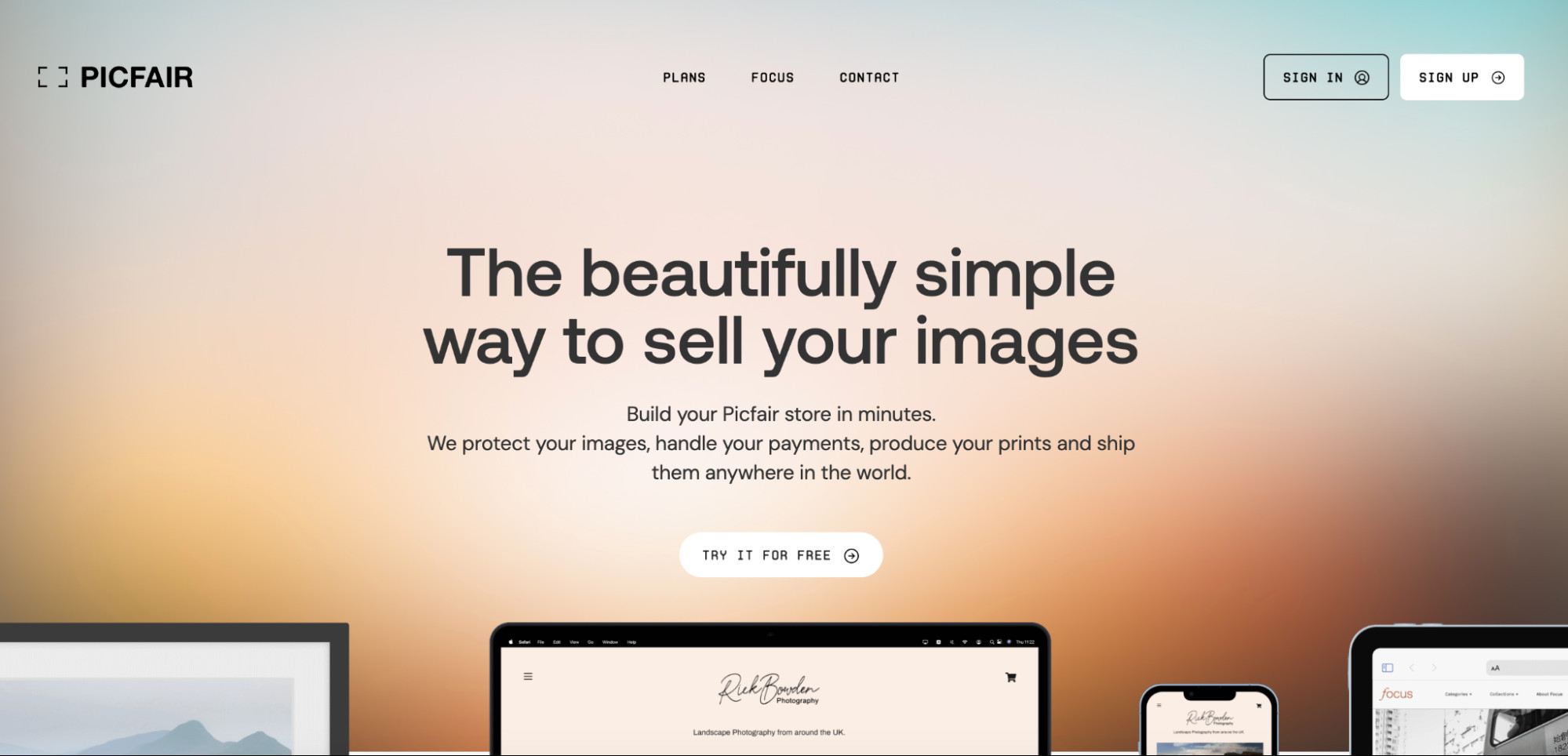 Picfair landing page promoting a website builder tailored for photographers to create their online stores.
Picfair landing page promoting a website builder tailored for photographers to create their online stores.
Picfair stands out by offering photographers enhanced control over their online photo portfolios and sales. Picfair is an excellent option if you desire a greater degree of autonomy in managing your online presence and pricing. You have the flexibility to set your own prices for both photo prints and digital downloads. Picfair streamlines the sales process by handling payment processing and also manages print production, shipping logistics, and licenses for digital images, simplifying operations for photographers.
How to get paid
To leverage the full features of Picfair, you can subscribe to a Plus plan, priced at $5 per month when billed annually. This plan enables you to create a customized Picfair store capable of hosting up to 10,000 images, which can be offered as prints or digital downloads, providing a robust platform for selling your photography.
8. Adobe Stock
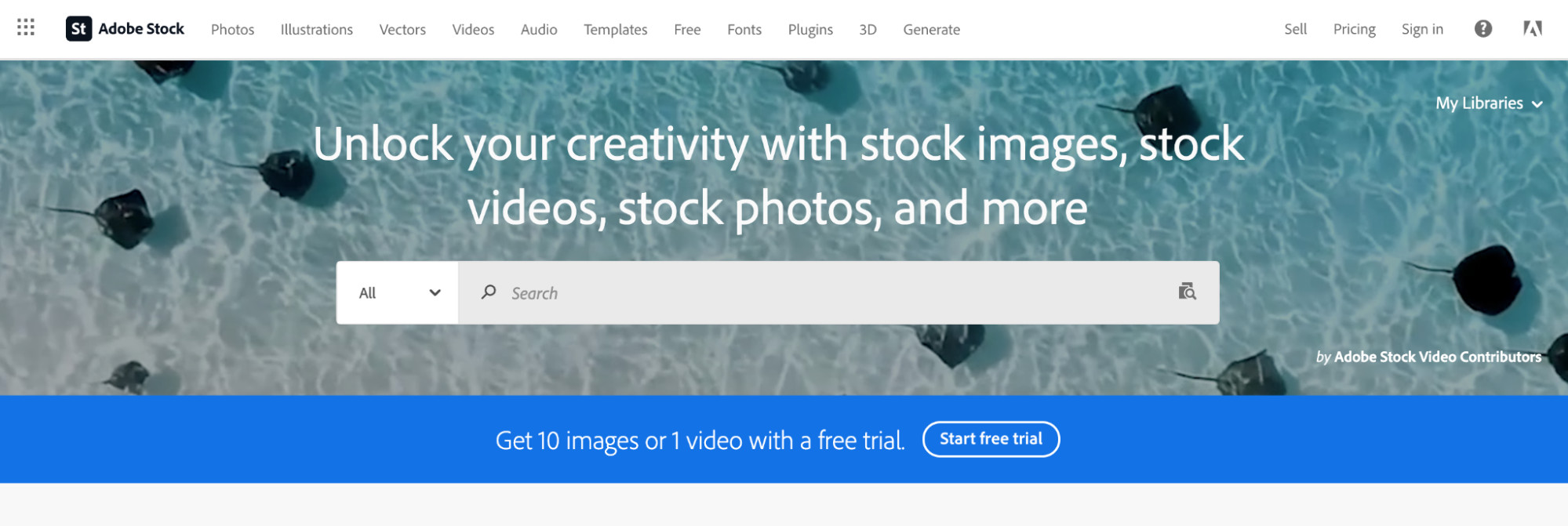 Adobe Stock homepage featuring a search bar against a backdrop of stingrays in the ocean, highlighting its integration with Adobe software.
Adobe Stock homepage featuring a search bar against a backdrop of stingrays in the ocean, highlighting its integration with Adobe software.
Adobe Stock offers seamless integration with Adobe’s widely-used suite of photography software, a significant advantage for users within the Adobe ecosystem. If you are a regular user of Adobe Creative Cloud applications for your photography workflow, Adobe Stock provides a convenient and integrated platform to add your images, videos, vectors, and illustrations to their online stock photo marketplace.
How to get paid
Adobe Stock simplifies the upload process by allowing contributors to upload assets directly from within Lightroom and Bridge upon completing their editing workflow. Contributors linking their Adobe ID to Adobe Stock can earn a 33% royalty on photo sales and a slightly higher 35% on video content, providing a straightforward monetization path for Adobe users.
9. Envato Elements
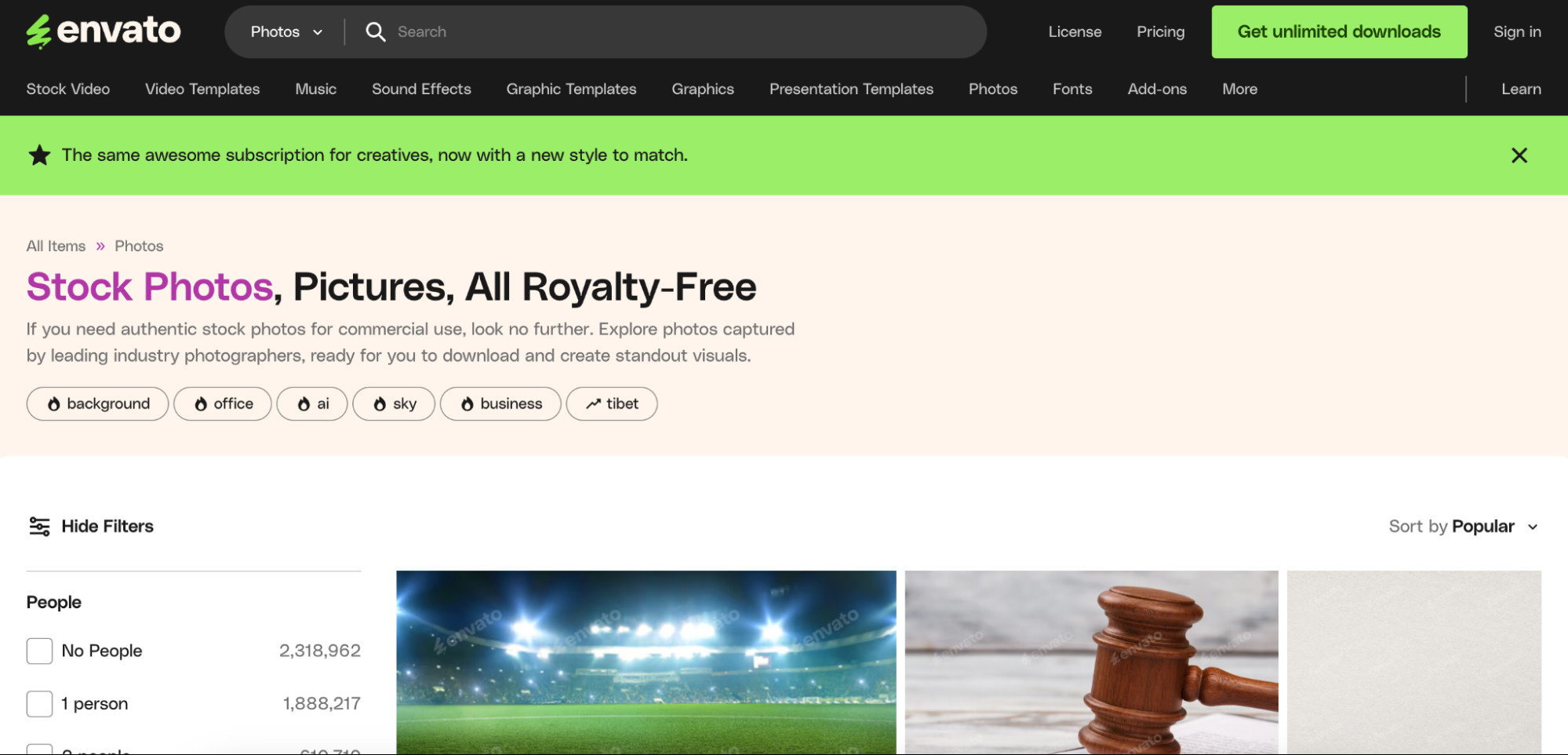 Envato Elements landing page for stock photos, promoting revenue sharing for contributors.
Envato Elements landing page for stock photos, promoting revenue sharing for contributors.
Envato Elements provides a subscription-based stock photography platform where photographers can sell photos online and connect with a broad range of potential clients. Envato Elements operates on a subscription model, offering users unlimited downloads for a flat fee. As a contributor, you earn a share of the total subscriber revenue, aligning your income with the platform’s overall performance.
Envato Elements offers flexibility in how you sell your photos. You can sell directly through their platform’s app or opt to upload photos to your own website while still leveraging the Envato Elements domain, providing versatile options for reaching buyers.
How to get paid
Contributors to Envato Elements earn a share of the net subscription revenue, with rates ranging from 25% to 50%. The specific percentage depends on various factors, including the type of content and the contributor’s tier.
10. Unsplash+
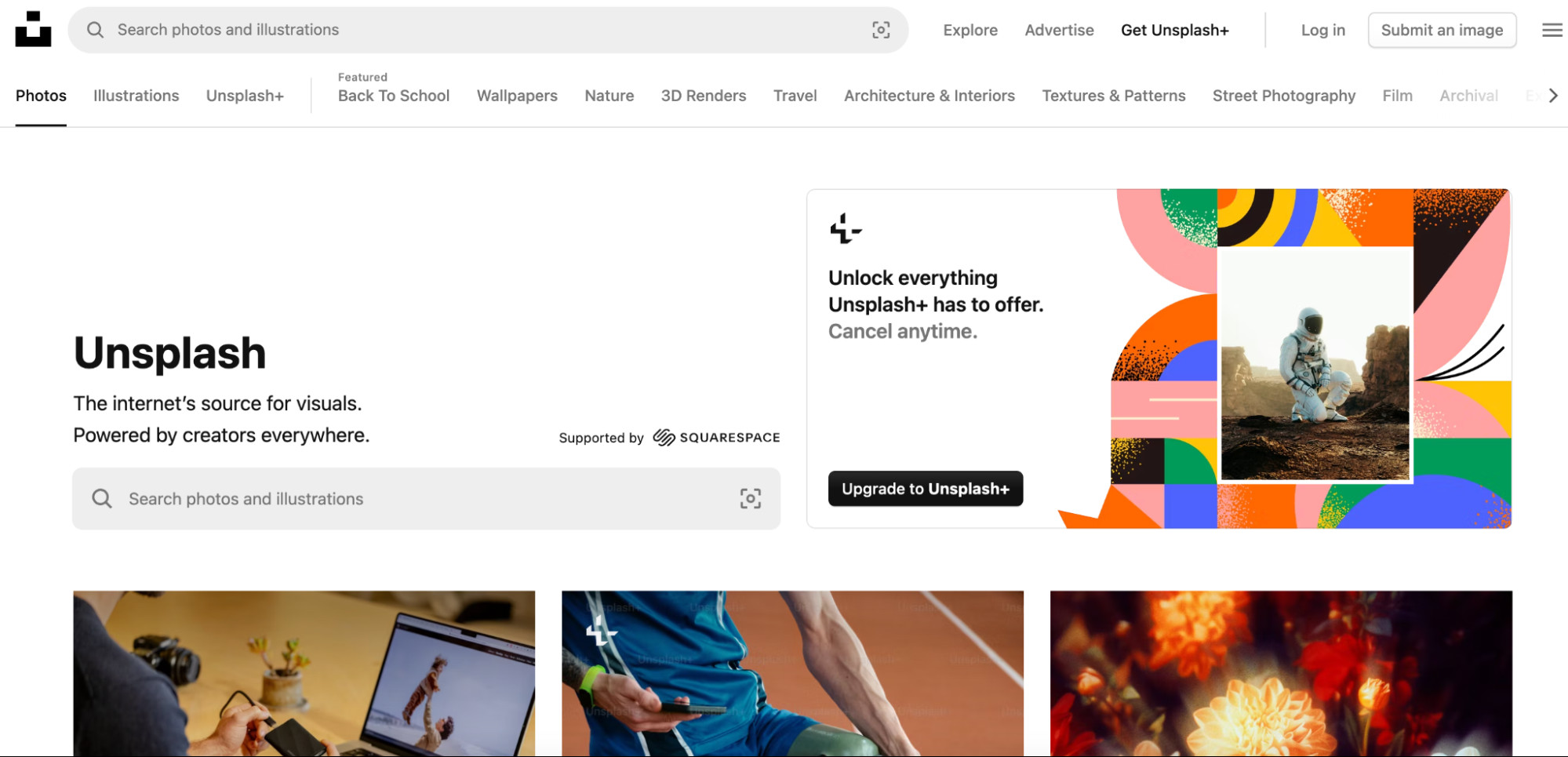 Unsplash homepage showcasing stock photos and a call-to-action to contribute to Unsplash, highlighting paid assignments.
Unsplash homepage showcasing stock photos and a call-to-action to contribute to Unsplash, highlighting paid assignments.
Unsplash+ operates differently from traditional stock photo sites. While Unsplash is widely known for its free stock photos, Unsplash+ is its premium, paid platform. Notably owned by Getty Images, Unsplash+ compensates photographers not based on individual photo sales but rather for submitting images that meet specific assignment briefs.
Instead of directly licensing individual photos, Unsplash+ partners with contributors through its program where photographers respond to specific briefs and requests from clients. This model offers a more proactive approach to earning, where photographers can target their submissions based on current market demands.
How to get paid
To participate in Unsplash+, photographers must complete the contribution application and be accepted into the program. Once accepted, contributors gain access to a list of briefs created by Unsplash customers. Photographers select briefs that align with their skills, upload relevant photos, and get paid for each image that is accepted and meets the brief requirements. Payment rates for photos vary depending on the brief and image usage, generally ranging from $5 to $30 per accepted image.
11. Dreamstime
Alt text: Dreamstime website front page with a search bar and examples of stock photos, highlighting its extensive library of over 250 million files.
Dreamstime is a well-established microstock platform offering a vast library of royalty-free media. Dreamstime’s extensive collection encompasses over 250 million files, including stock photos, vector graphics, videos, and audio files. With a user base exceeding 50 million, Dreamstime provides photographers access to a large and active audience of potential image buyers.
How to get paid
Dreamstime offers a revenue sharing model that ranges from 25% to 50% for non-exclusive content, providing a tiered commission structure. Photographers who choose to contribute exclusively to Dreamstime can earn an additional 10% commission and also receive a bonus of 20¢ for each approved submission, incentivizing exclusivity. Dreamstime also features an affiliate program that pays 10% of transaction values generated by referred contributors or customers, offering another avenue for income generation.
12. Snapped4U
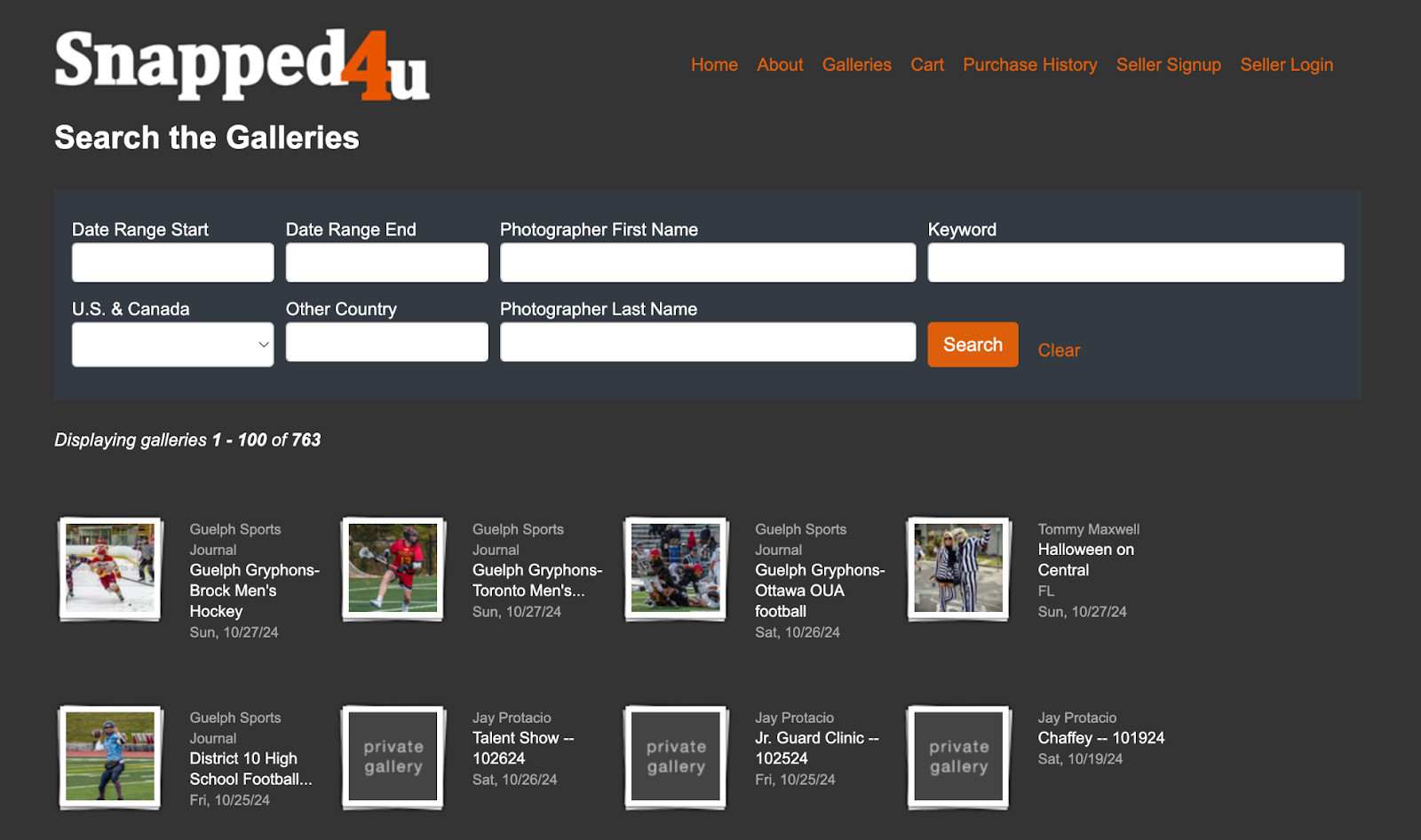 Snapped4U homepage showcasing photos from sports photographers, emphasizing its niche in event and portrait photography.
Snapped4U homepage showcasing photos from sports photographers, emphasizing its niche in event and portrait photography.
Snapped4U carves out a niche as a specialized photo marketplace focusing on event and portrait photographers. Snapped4U is specifically designed for photographers who specialize in capturing portraits and event photography. The platform enables photographers to create personalized galleries, set their own prices for their images (up to $20 per image), and directly sell digital files to clients.
Snapped4U is tailored for photographers selling images directly to customers who attended specific events or portrait sessions. It’s important to note that the platform is not designed for general stock photos such as travel, landscape, or still-life photography, focusing instead on event-specific and portraiture content.
How to get paid
Snapped4U operates with a straightforward fee structure. It charges a one-time $10 registration fee upon sign-up and retains a commission ranging from 10% to 12% on each sale. Photographers receive their account balance payouts via PayPal on the 1st and 15th of each month, ensuring regular payment cycles.
13. Foap
 Foap creator landing page promoting a mobile app for photographers to sell photos directly to brands.
Foap creator landing page promoting a mobile app for photographers to sell photos directly to brands.
Foap distinguishes itself by enabling photographers to directly sell commercial-quality images to brands and individual buyers. Foap acts as a platform connecting photographers directly with brands and individuals seeking authentic, user-generated content. A key feature of Foap is “missions,” where brands initiate specific photo or video briefs, and photographers can participate by submitting relevant content for a chance to win rewards. Foap has distributed over $3 million to creators to date, indicating its active marketplace and opportunities for photographers.
How to get paid
Mission payouts on Foap can range significantly, from $100 up to $2,000, depending on the mission’s scope and brand requirements. Beyond missions, users can also sell individual photos through the Foap market. Foap retains a 50% commission on all sales, irrespective of whether they are mission-based or direct marketplace sales.
14. EyeEm
 EyeEm homepage showcasing a search bar and logos of high-profile clients, emphasizing its community and marketplace.
EyeEm homepage showcasing a search bar and logos of high-profile clients, emphasizing its community and marketplace.
EyeEm uniquely combines a vibrant photographer community with a commercial marketplace for photo licensing. EyeEm fosters a community aspect alongside its marketplace, encouraging photographers to connect and engage with each other. The platform frequently hosts “missions,” which are themed photo contests or briefs inviting photographers to submit images aligned with specific themes, enhancing engagement and content diversity.
How to get paid
Contributors to EyeEm earn a 50% commission on each sale made through the EyeEm marketplace. Payments to photographers are processed via PayPal, providing a convenient and widely used payment method.
15. Pond5 (for videos)
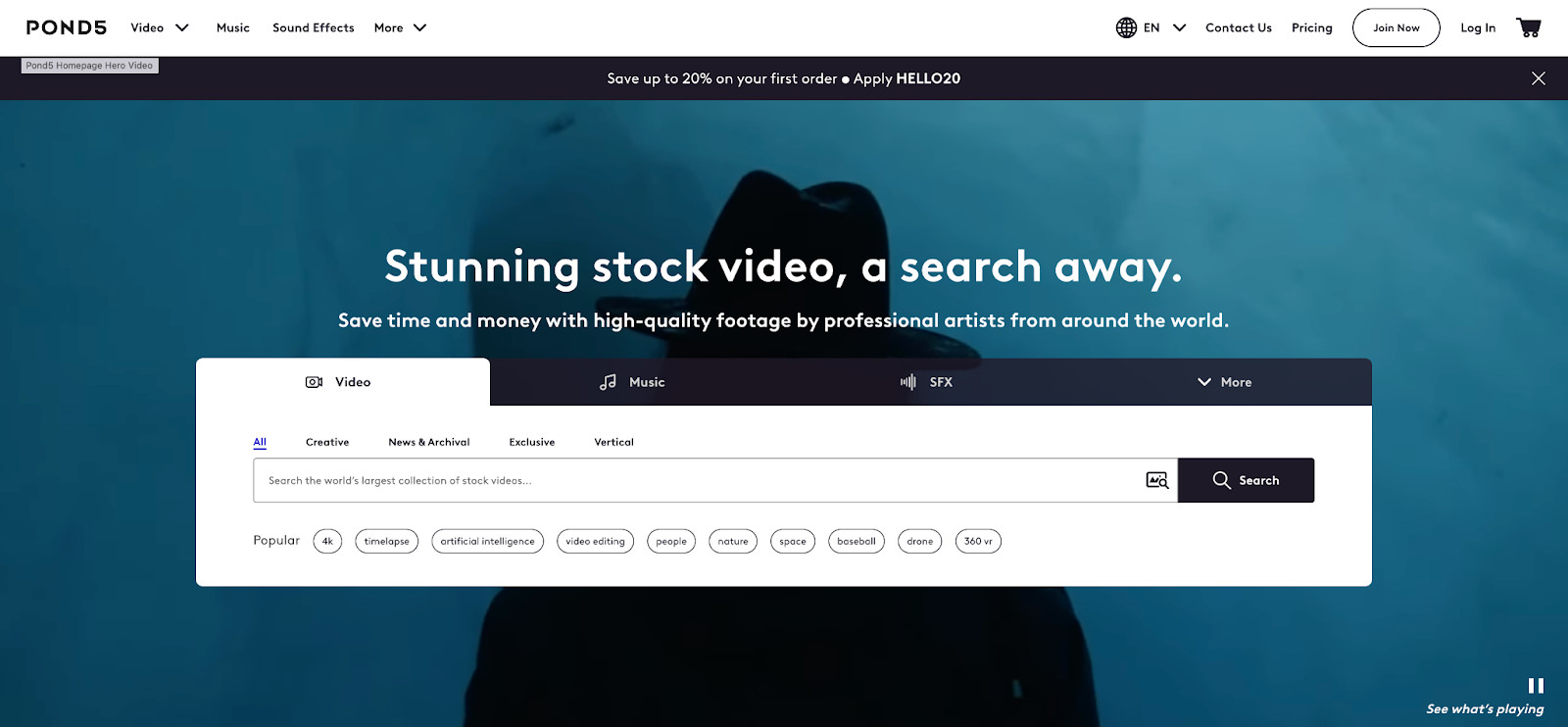 Pond5 homepage for video content marketplace, highlighting its focus on video, music, and sound effects.
Pond5 homepage for video content marketplace, highlighting its focus on video, music, and sound effects.
Pond5 differentiates itself from the previously listed platforms by specializing in video content alongside other media assets. Unlike sites primarily focused on photos, Pond5 is a leading marketplace for selling royalty-free videos, as well as music tracks, sound effects, and other multimedia assets. Pond5 boasts a substantial customer base of one million, including prominent clients like the BBC and Disney, indicating its credibility and reach within the media industry. Contributor content on Pond5 is utilized in diverse projects, ranging from advertisements and TV shows to feature films.
How to get paid
Video artists contributing to Pond5 earn a 40% royalty share on their sales. Pond5 offers an option for contributors to make their content exclusive to the platform, which can increase the royalty rate up to 60%, incentivizing exclusivity. Contributors can also respond to specific client briefs through the Artist Portal. Pond5 further provides a referral program, enabling artists to earn additional income by referring new contributors or customers to the platform.
Tips for Selling Photos Online
To build a successful stock photo business, consider these key tips:
Define your Stock Photography Niche
Many successful stock photographers develop a recognizable style or concentrate on specific themes within their work. Whether your passion lies in travel, fashion, nature, or culinary photography, consistency in style and subject matter can be beneficial.
Finding your niche often involves experimenting with different styles and subjects you enjoy shooting and observing audience engagement. Keyword research can be invaluable in assessing the market demand for specific topics within your photography. Tools like Google Trends can provide insights into the popularity of various image topics and emerging trends.
Leverage Instagram
Similar to bloggers and YouTubers, photographers looking to sell images online should prioritize building their online audience.
Visually-driven social media platforms, especially Instagram, offer powerful channels to reach a broad audience. Utilizing Instagram tools can help you identify relevant accounts to follow, engage with trending hashtags, and cultivate a following of potential customers and clients.
Linking your social media accounts streamlines photo sharing across multiple platforms, boosting your overall visibility and reach. Instagram, for example, allows you to link your accounts to automatically cross-post images to Facebook, expanding your social media presence efficiently.
Integrate Ecommerce into Your Website
Most photographers maintain their own websites to showcase their portfolios to prospective clients. By integrating a Shopify Buy Button into your website, you can directly facilitate customer purchases of your stock images or prints.
Photographer Dave Sandford, for example, effectively uses his website as both a portfolio to display his wildlife photography and an ecommerce platform where visitors can purchase prints and calendars.
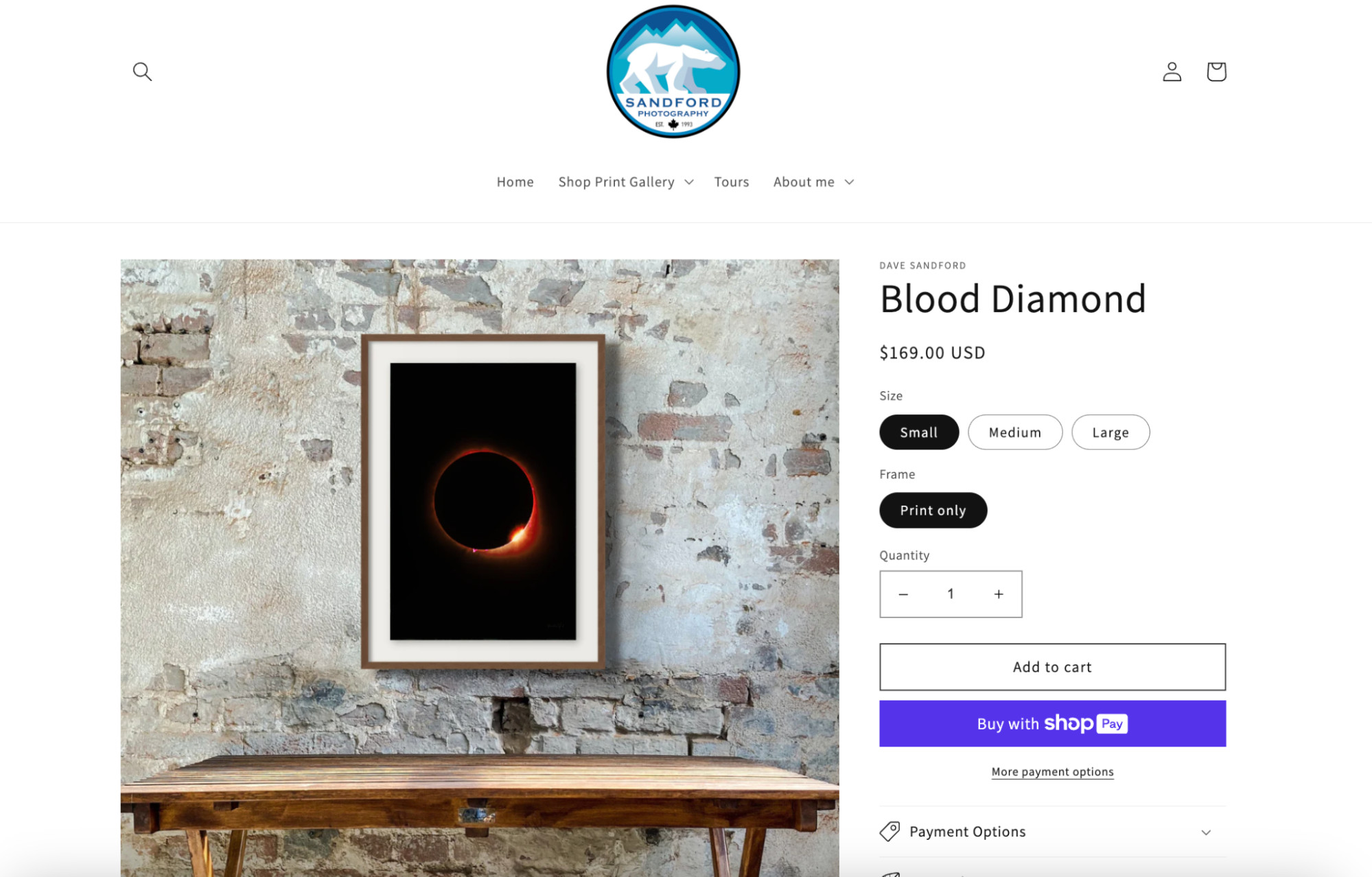 Product page showcasing a moon print with a red border against a black backdrop, exemplifying an ecommerce photography product.
Product page showcasing a moon print with a red border against a black backdrop, exemplifying an ecommerce photography product.
Creating a personalized portfolio page or online store using a platform like Shopify is often the most straightforward way to sell photos online directly to customers.
Utilize pre-designed art and photography themes to quickly set up your digital storefront, or combine a free theme with a dedicated gallery app for enhanced image presentation and sales functionality.
Understand Your Market
Identifying your target market is crucial – these are the individuals or entities most likely to purchase your photos. Understanding their demographics, interests, and purchasing behaviors allows you to tailor your photography to meet their needs and preferences.
For example, if you specialize in wedding photography, your target market for stock images isn’t necessarily engaged couples. Instead, it’s likely to be businesses operating within the wedding industry, such as wedding stationery brands or suit retailers, seeking royalty-free images of wedding celebrations for their marketing collateral.
By understanding this buyer persona, you can create images that resonate with their needs and preferences, offer them on platforms where they actively search for stock photos, and price your work competitively within their budget.
How to Set Up Your Online Portfolio
Follow these steps to effectively launch your online photography portfolio:
1. Choose the Right Platform
There’s no single “best” platform for monetizing your photos; the ideal choice depends on your specific goals for your photography business and the level of control you desire over your imagery and business operations.
Here’s a quick overview of platform options based on different objectives:
- For Hobbyists or Passive Income: If you aim to upload photos as a hobby or generate modest passive income, consider stock photo submissions on platforms like iStock or Alamy, which offer straightforward submission processes and broad market reach.
- For Brand Assignments: To secure assignments from brands without proactive pitching, apply to become an Unsplash+ contributor. This platform connects photographers with brands seeking specific imagery, streamlining the process of obtaining paid assignments.
- For Full Business Control: For complete control over your photography business, including branding, pricing, and customer relationships, opt for an ecommerce platform like Shopify. This provides the tools to build a dedicated online store and manage all aspects of your sales and marketing.
2. Plan Your Portfolio’s Structure
Your portfolio serves as a visual resume for potential clients, showcasing your past work and influencing their decision to purchase your photos or hire your services.
Pay attention to these critical elements when structuring your portfolio:
- Layout: While photos should be the focal point, providing context is beneficial. Concise image descriptions can influence purchasing decisions and enhance your portfolio’s visibility in search engine results by incorporating relevant keywords.
- Social Proof: Social proof demonstrates the popularity and credibility of your work. Include testimonials from satisfied customers or highlight instances where your images have been used in successful campaigns to build trust and encourage purchases.
- Categories and Organization: Facilitate easy browsing for potential customers by implementing clear categories and organization. Tag and categorize images logically. For instance, a nature photographer might organize collections by location, environment, subject, or date.
- Gallery Size: Curate your online portfolio to showcase only your highest quality work. Eliminate any photos you’re not entirely satisfied with. Limit galleries to a selection of images that represent your best skills and style, ensuring a strong and impactful impression.
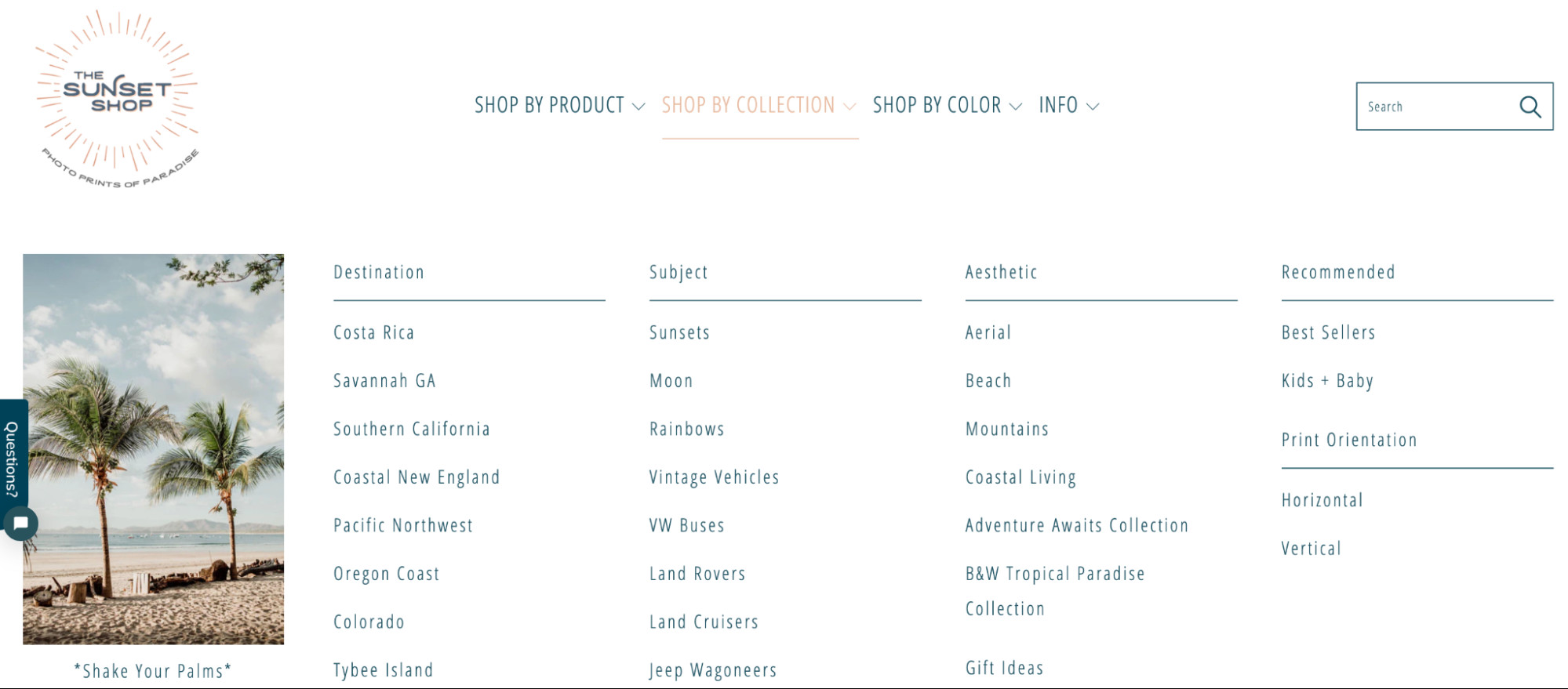 Example product categories like “Costa Rica”, “Sunset”, and “Mountains” on a photo print website, illustrating organization for user navigation.
Example product categories like “Costa Rica”, “Sunset”, and “Mountains” on a photo print website, illustrating organization for user navigation.
The Sunset Shop demonstrates effective categorization by photo type, aesthetic, and destination, enhancing user navigation.
3. Optimize Images for the Web
Photographers often face the challenge of compressing high-resolution images for online display. However, fast-loading images are crucial for positive user experience. Large image files can significantly slow down webpage loading times, and most visitors are unwilling to wait for slow site speeds.
When uploading images to your online photography portfolio, follow these optimization best practices:
- Compress Image Sizes: Reduce file sizes as much as possible without sacrificing image quality. A general guideline is to aim for compression between 60% and 80%, balancing file size and visual fidelity.
- Use Descriptive File Names: Employ descriptive file names that incorporate relevant keywords. For example, use “summer-evening-nature.jpg” instead of generic names like “IMG_3542.jpg.”
- Write Alt Text: Add descriptive alt text to each image. This text serves two key purposes: it helps search engines understand the content of your photos for improved SEO, and it provides accessibility for visually impaired users who rely on screen readers.
4. Create an About Page
People connect with stories and personalities. An engaging About page helps prospective customers learn about you, the photographer behind the images. Include a brief summary of who you are and your journey into photography.
This is your opportunity to build a unique and compelling personal brand. Share your passion for photography. How did you begin in the industry? What subjects do you love to photograph? Where do you find your creative inspiration? A well-crafted About page can establish a personal connection and encourage visitors to engage with your work.
5. Implement Ecommerce Functionality
An integrated ecommerce platform streamlines the process of selling photos online, handling essential logistical aspects. Choosing a platform like Shopify to build your portfolio provides seamless ecommerce functionality, enabling you to:
- Build a user-friendly online storefront where customers can browse and purchase your photos directly.
- Extend your reach to social media storefronts like Instagram Shop, expanding your sales channels.
- Securely process payments from customers and manage sales tax calculations.
- Efficiently deliver your products, whether physical prints or digital downloads, to customers.
- Manage and track marketing campaigns to promote your photography and drive sales.
 Product page for a 5×7 printed photo of a beach, illustrating online print sales through ecommerce.
Product page for a 5×7 printed photo of a beach, illustrating online print sales through ecommerce.
The Bee & The Fox effectively utilizes Shopify to sell photography prints online, demonstrating the platform’s ecommerce capabilities for photographers.
6. Ensure Mobile Compatibility
Website traffic increasingly originates from mobile devices. Studies indicate that more than half of global website traffic comes from mobile devices. Therefore, ensuring your online portfolio is fully mobile-compatible is crucial. Verify that your site displays correctly and functions smoothly on smaller screens.
Having a mobile website involves implementing responsive website design principles, optimizing image display for vertical screens, and using appropriately sized, finger-friendly buttons and navigation elements.
7. Launch and Promote Your Photos
Once your portfolio is set up, it’s time to share your work with the world and drive traffic to your site. Utilize various marketing tactics to promote your photography and portfolio:
- Repost images regularly on social media platforms to maintain visibility and engagement.
- Pin visually appealing photos on Pinterest and link them back to relevant pages on your portfolio site to drive referral traffic.
- Consider gifting free prints to influencers or bloggers in related niches to gain exposure and potential backlinks.
- Create engaging behind-the-scenes content showcasing your photography process on platforms like TikTok, YouTube, or Instagram Reels to attract and engage audiences.
- Build an email list by offering website visitors a discount code on their first order in exchange for their email address, enabling direct marketing and customer relationship building.
How to Sell Photos as Prints and Photo Books
Beyond digital licenses, selling physical products featuring your photography, such as prints and photo books, can create additional revenue streams. Selling your own physical products can be more straightforward than you might think.
You can generate income by selling photos as paper prints or by featuring them on various physical products like mugs, t-shirts, and calendars. Popular platforms and tools for print and product sales include:
Working with a local photo lab can simplify the process of shipping and selling prints. Alternatively, partnering with a print-on-demand company enables you to dropship a wide array of products (prints, phone cases, pillows, etc.) featuring your photos without managing inventory.
Always order samples of products before offering them for sale to ensure the print and product quality meet your photographic standards and customer expectations.
How to Sell Photography Online as Photo Books
Photo books represent another valuable physical product format for showcasing and selling your photography. Niche and thematically consistent photography collections are particularly well-suited for creating compelling photo books. Selling your art online in photo book format can tap into a different market segment interested in tangible photographic collections.
While print-on-demand services may offer lower profit margins compared to handling printing and fulfillment yourself, they provide a risk-free way to test market demand for your photo books before investing in larger upfront print runs.
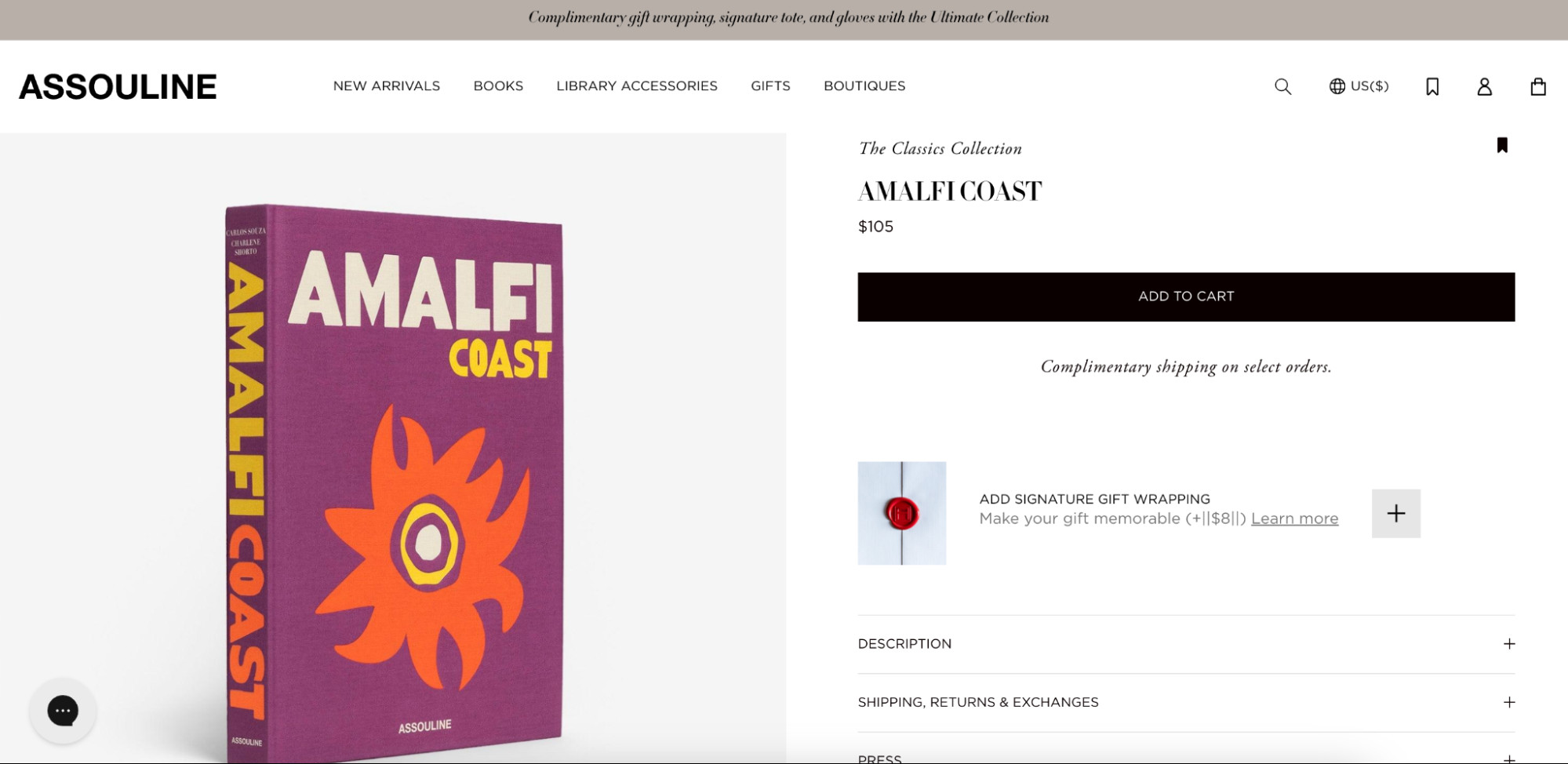 Photobook featuring images of the Amalfi Coast, showcasing premium photo books as a product.
Photobook featuring images of the Amalfi Coast, showcasing premium photo books as a product.
Assouline exemplifies premium photobooks featuring images from popular travel destinations, demonstrating the potential for high-end photo book sales.
How to Sell Your Photography Services
Beyond stock photography, numerous business opportunities exist for professional photographers, including event coverage, fashion shoots, and product photography.
You can list your services on freelance directories like Fiverr and Upwork to connect with potential clients. Networking locally and engaging with clients via video conferencing can also expand your client base.
Here are networking tips for promoting and selling your photography services:
- Carry Business Cards: Always have business cards readily available for networking opportunities. Utilize Shopify’s free business card generator to create professional-looking cards.
- Optimize LinkedIn Profile: Refine your LinkedIn profile to showcase your photography work and optimize it with keywords related to your primary service offerings, such as “event photographer” or “product photographer.”
- Attend Networking Events: Focus on networking events frequented by entrepreneurs and event organizers, as these individuals often require professional photography services.
- Build a Personal Brand: Regularly share your photography work on social media platforms to maintain visibility and stay top-of-mind when individuals or businesses in your network need photography expertise.
For service-based photography, efficient scheduling is essential. Utilize a booking platform to allow prospective clients to view your availability and book sessions directly.
Platforms like Setmore and SimplyBook.me offer free plans with features suitable for photographers’ scheduling needs. If you use Shopify for your portfolio, you can integrate a scheduling app to enable appointment booking directly through your website.
Pricing Strategy for Selling Photos Online
Your talent and dedication are key determinants of your earning potential when selling photos online. However, strategic pricing is essential to maximize your income.
Here’s how to approach pricing for your photography business:
- Conduct Market Research: Inquire with your target market about their price expectations for your photos and research the pricing of comparable images on stock photo sites.
- Determine Profit Margins: Factor in all costs associated with photography, including equipment, website hosting, and marketing expenses. Ensure your photo sales revenue contributes adequately to covering these costs and generating profit.
- Price Based on Usage: Differentiate pricing based on usage rights. Exclusive photos, granting sole usage rights, command higher prices than non-exclusive licenses.
- Offer Discounts Strategically: Experiment with discounts and promotions to incentivize purchases, whether for first-time buyers or to reward loyal customers.
- Consider Product Bundles: Instead of selling individual photos, create and offer collections of related images at a bundled, discounted price. For instance, a single beach photo might be priced at $2.99, while a bundle of five beach-themed images could be offered at $9.99.
Legal Primer for Selling Your Photos Online
Understanding basic legal terms and concepts related to rights and licenses is essential for protecting your photography when selling online.
Disclaimer: This is not legal advice, but a simplified glossary of common terms.
Glossary of Legal Terms for Selling Photos Online
- Editorial Use: Permission granted to use a photo in editorial contexts like blogs, newspapers, magazines, and news publications.
- Commercial Use: License allowing the use of a photo in marketing and advertising materials to promote products or services.
- Retail Use: Permission to use a photo to create physical products for sale, such as prints, posters, mugs, or apparel featuring the image. Often considered within commercial use but should be distinguished.
- Exclusive Use: A license granting the purchaser sole and exclusive rights to use the photo, preventing others from licensing it.
- Non-Exclusive Use: A license allowing multiple individuals or entities to purchase and use the same photo simultaneously. Typically less expensive than exclusive licenses.
- Public Domain: Photos with no copyright restrictions or claims. They can be used for commercial, editorial, and personal purposes without permission. Works by US federal government agencies are often in the public domain unless specified otherwise.
- Creative Commons: Licenses that allow conditional usage of your work, provided the user complies with specified restrictions. Attribution to credit the creator is sometimes required. Creative Commons offers tools to generate free badges for these licenses.
- Royalty Free: A license granting the purchaser the right to use a photo for an unlimited duration and an unlimited number of times after paying a one-time fee. Commonly non-exclusive and typically more affordable.
- Rights Managed: A license granting one-time use of a photo with specific restrictions on distribution and usage. Additional licenses must be purchased for subsequent uses.
- Right of Publicity: Individuals featured in your photos have certain rights concerning their image, especially for commercial use. Obtaining explicit permission from subjects is crucial, particularly when selling photos online for commercial purposes.
What to Do if Someone Steals Your Photos
Content theft is unfortunately common online, often occurring unintentionally.
Photographers can proactively protect their digital images by watermarking them before selling or sharing online. Watermarks can be applied in Photoshop or using a watermark generator.
Smaller watermarks, often placed in a corner, are less visually intrusive, while larger watermarks with reduced opacity offer stronger protection against unauthorized use.
If you discover your photos being used without permission, a cease and desist request is often an effective first step. Alternatively, you can send an invoice to the infringing party for unauthorized usage. Combining both approaches—a cease and desist notice and an invoice—can be particularly persuasive, offering the choice to either pay for usage or remove the photo.
At a minimum, strive to ensure proper attribution whenever your work is used, even for editorial purposes. Remember that backlinks to your portfolio site are valuable for driving traffic, improving search engine optimization, and enhancing your website’s ranking in Google search results.
Shopify provides solutions for sellers of all sizes, from individual photographers to large retailers. Explore plans and pricing to find the right fit for your photography business.
Read More
[Link to relevant blog posts or resources]
How to Sell Photos Online FAQ
What is the best way to sell photographs?
Selling photographs as stock images on third-party websites like iStock, Shutterstock, or Alamy is often considered the best way to sell photographs online, especially for beginners. Stock sites offer ease of use, broad market access, and affordability.
Where can I sell my photos online for money?
Here are platforms where you can sell photos online for money:
- Alamy
- 500px
- Shutterstock
- Getty Images
- iStock
- Stocksy
- Picfair
- Adobe Stock
- Envato Elements
- Unsplash+
- Dreamstime
- Snapped4U
- Foap
- EyeEm
- Pond5 (for videos)
How do you make money from stock photography?
Stock photography websites or agencies act as intermediaries, selling licenses for high-quality images uploaded by photographers. These agencies license individual images to clients for a set price, and the photographer receives a royalty payment for each license sold.